Chart Building 101
Building charts in Capture2Proposal is an easy and effective way to get the most out of your data. Each chart updates with every update to your pipeline or award analytics data filter options, giving you virtually unlimited ways to slice, dice, and (most importantly!) analyze the results.

Charts can be included report components, and/or saved to your favorite graphs for easy access and reuse. The directions below will walk you through each component of building a chart, including saving and accessing favorites.
Watch this video to learn about our chart and graph options. Or, read below to see step by step instructions.
Capture2Proposal has eight chart and graph types available for use. They are represented by the icons in the chart settings area.
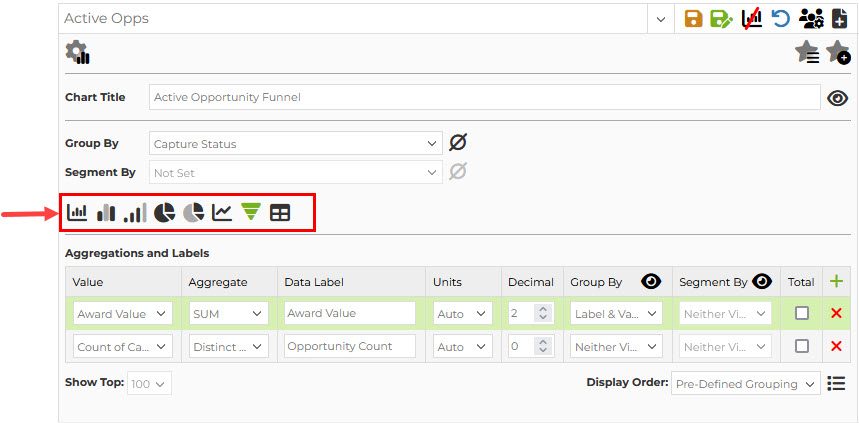
![]() Bar Graph and Stacked Bar Graph
Bar Graph and Stacked Bar Graph
This chart type is the most commonly used, and works with both group by (x-axis) and segment by (stacked values) options. C2P bar graphs have vertical bars, and are limited to 100 bars or fewer per graph.
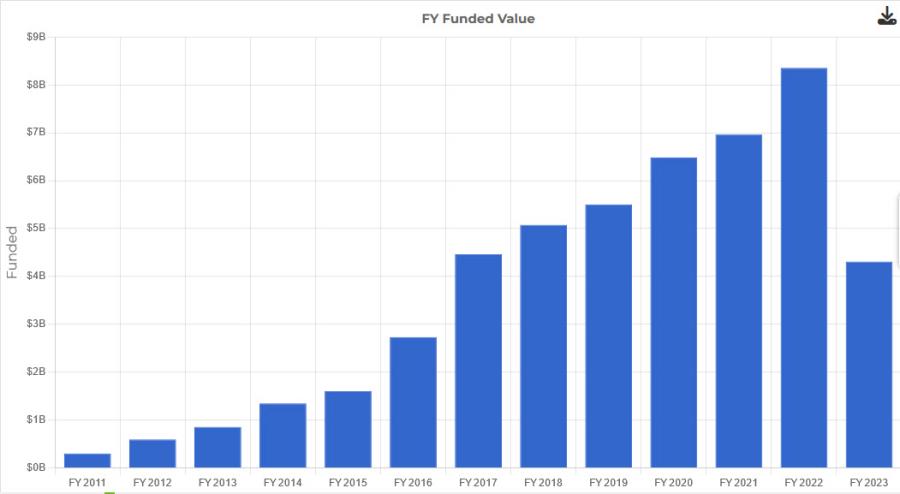
![]() Clustered Bar Chart - Standard
Clustered Bar Chart - Standard
![]() Clustered Bar Chart - Continuous
Clustered Bar Chart - Continuous
Clustered bar charts are useful for showing the level of effort for each individual segment grouped together on the x-axis for a side-to-side comparison of the data.
A standard clustered bar chart shows blank spaces where there is no data for a specific segment within that x-axis grouping. It gives a quick visual presentation of where data is null or missing.

A continuous clustered bar chart removes the empty spaces for null columns. The view is smoother, and often used when a clustered bar chart is selected with a date-based x-axis. However, it is more difficult to identify null data without carefully tracking the legend and bar colors in the chart. It will not hide an x-axis value for which there is no data for any of the segments, as seen below.
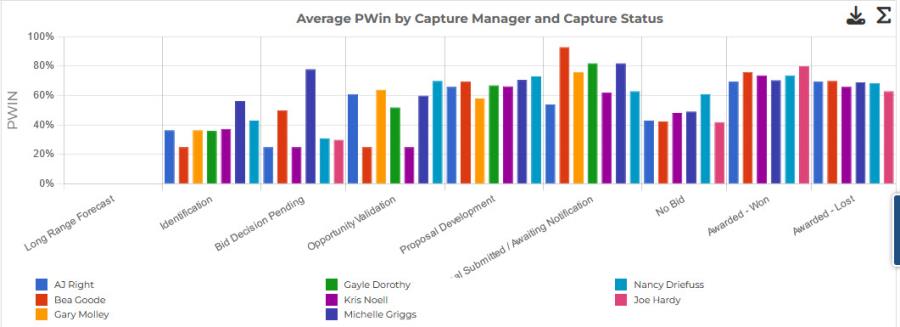
![]() Pie Chart - Limited to Top x Values
Pie Chart - Limited to Top x Values
![]() Pie Chart
Pie Chart
Pie charts are great for quickly gauging what portion of a total is comprised of its pieces. Capture2Proposal's pie charts are built using a single grouping to determine the pie segments; these segments cannot be further subdivided into additional groupings. If you switch a graph setting from a type that uses two groups, such as a clustered bar chart, the setting for the segments in that chart will not be applied in the pie chart, but you value that had been used for the segmenting will be maintained, so don't worry abut trying different chart types out and losing information.
A pie chart limited to the top x values will only show those segments, so if x = 5, then the whole pie will be the combined value of the top five elements in the data set. The data set shown on the page will still include all of the elements; it will not be filtered to include only the top x values.
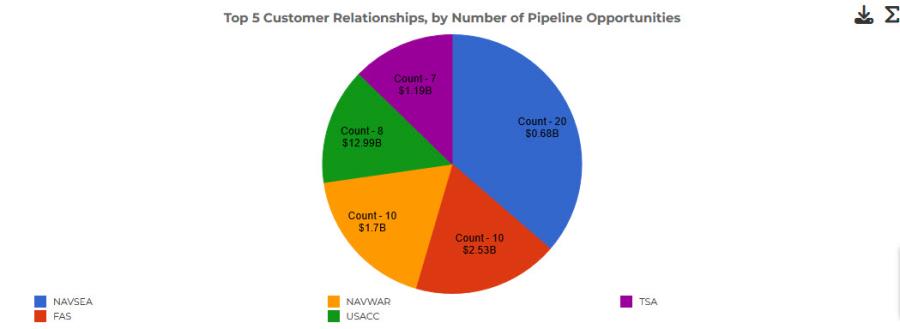
A standard pie chart will not be limited to the top x values, however, it will show "other" for the remaining values after the top x. This allows you to clearly see how large a portion of the total the top x represents.
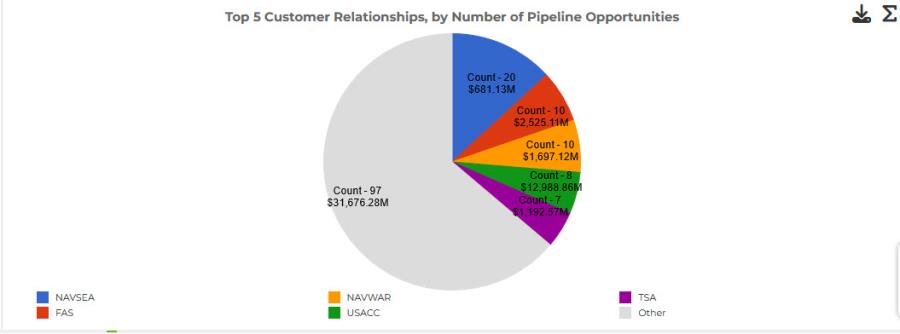
![]() Line Graph
Line Graph
Line graphs are another great way to represent changes over time. They also are great for seeing the relative values of various segments of the data, similar to a cluster bar chart view. These graphs often require a clean set of data, but can be used to great effect for analyzing trends.
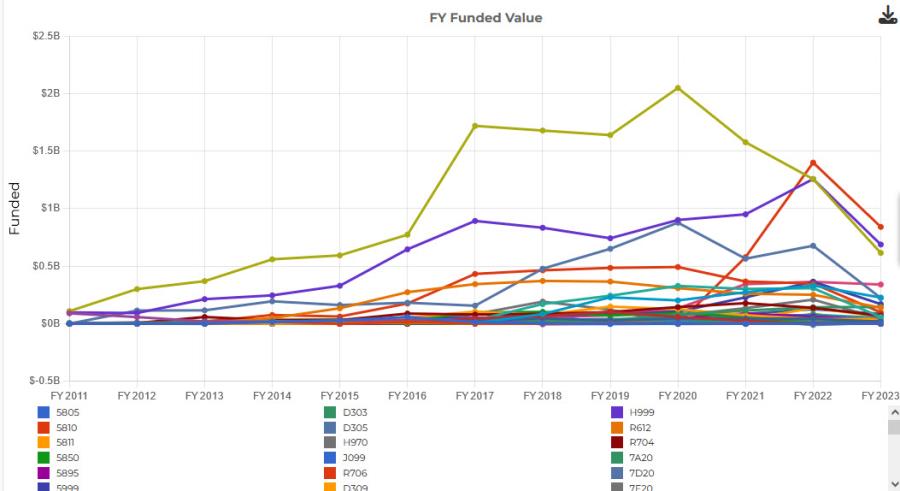
![]() Funnel Chart
Funnel Chart
Funnel charts are best used for processes. This is the default chart setting for charts built with Capture Status as the grouping mechanism, although the chart type can be changed. The shape of the funnel lets you know the health of the process; is it truly funnel shaped as you move through the steps of the process?

![]() Table
Table
While our full data set is a table already, using a table in the charts is a great way to pull together different aggregates. Like with Pie Charts, Capture2Proposal's tables are built using a single grouping to determine the pie segments; these segments cannot be further subdivided into additional groupings. However, the use of chart aggregations and the easily visible data for all of the column values in tables makes the table a very powerful tool.

As you can see from the image below, the chart builder packs a lot of customization options into a small space! This page will explain each element. There are defaults set for many of these values, so it is not necessary to set a value for each field each time you build a chart. Instead, they are available for the greatest level of customization possible.
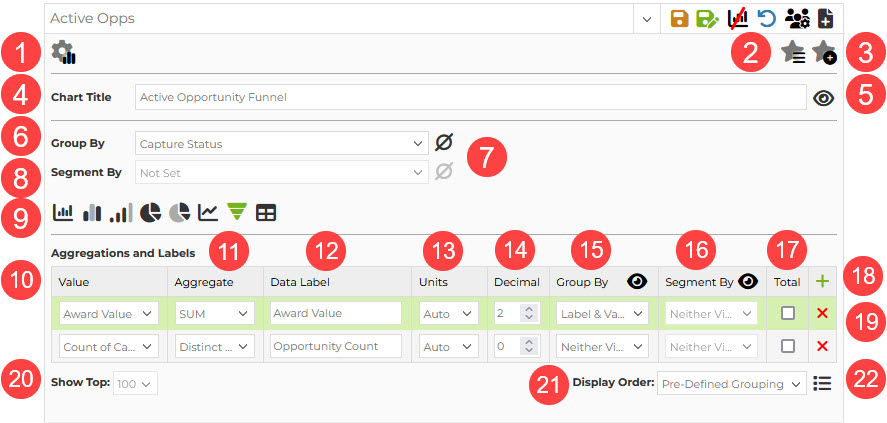
- Show/Hide Chart Settings: This icon will toggle between the view with the settings open or closed. Your most recent toggle setting will be applied when you return to the page after leaving.
- Favorite Charts: Click here to see a drop down list of your favorite charts to apply one to the page.
- Add to Favorites: Click this icon to save the current chart to your favorites list. This saves the chart to the list only; it does not save any filters applied to the dataset. If you are looking to save everything, you must save at the report level.
- Chart Title: The default shart title will be the report title. If you want to set a different title, enter it here.
- Show/Hide Title: Choose whether or not to show the title above the graph by toggling this setting.
- Group By: This value is the "determining factor" for the chart, i.e., the x-axis on graphs, the pie pieces on a pie chart, etc. Your Group by options on the pipeline page are all Capture2Proposal and custom capture date and drop down field types, plus a selection of other C2P fields that are well-designed for this type of analysis. In funded analytics, the options are all based on the award data fields available.
- Include/Exclude Nulls: Select this field to choose whether or not null values should be included in the results set. When the icon is green, null results will show in the chart.
- Segment By: This field can only be used in graph types that allow multiple groupings, such as bar graphs and line charts. The segment will be represented by the colorful segments in the graph, and will be identified by the legend.
- Chart Types: Toggle between the icons to change the chart type. To learn more about each type, click here.
- Value: While the Grouping determines what is important to measure, the value is the measure. The default value is a count of the group by category selected, but this can be changed to any numeric, currency, or percentage field offered by Capture2Proposal or available in your Custom Capture options. When more than one value exists, the top value is always the one used for measurement in all chart or graph types other than table, which shows each value as a separate column. Hovering over a graph segment will show all of the values included in this section; showing and hiding the values and labels without hovering will be set using fields 12-15. You can drag and drop rows to change the order of the values in the chart.
- Aggregate: Select what aggregate you want to use for the value. Some value types have limited options, but the full set of allowed calculations is: sum, average, min, max, count, distinct count, percent of total, and percent of displayed.
- Data Label: The data label field is hidden by default, and is set to Value - Aggregate by default. Click on the field and change the value to have a label that fits the style and data you want to convey with your chart. The data labels serve as the column headers in tables as well.
- Units: The default here is auto, which sets the units based on the average value of the displayed data. You can choose to set to none (ones), Thousands, Millions, Billions, or Trillions.
- Decimal: How many decimal places should be shown for the value. The default for this field is two.
Fields 15-17 all relate to data visibility at various levels of the chart, and options may be disabled when an option is not available with the current options selected for the chart. - Group By: The data visibility options for the group level of the chart. Selections here are column values in bar charts and stacked bar charts, or pie segments in pie charts, etc. For tables, each value is a column and setting the visibility here is not required.
- Segment By: The data visibility options for the segments. In a stacked bar chart, these will show in each colored segment, for example. In a clustered bar chart they will show for each bar.
- Total: This field allows you to display aggregates for the value across the displayed chart, and across the whole dataset. So if your chart shows the top 10 elements in the group, at the bottom of the chart you would see the aggregates for both the top 10 and for the entire dataset for comparison. These will show with the same aggregate type as selected in 11.
- Add Value: The green plus is used to add another value to the list of values calculated when building the chart.
- Delete Value: Use the x to remove a value from the chart calculations.
- Show Top X: Select how many groups to show in the results. Options range from 5-100. The default is 100.
- Display Order: The available options and the default display order will both vary based on the selected group by field. Value - High to Low is the most common setting for fields other than date fields. Pre-Defined Grouping refers to the order in which the fields appear in the drop-down list of options for that field within an opportunity.
- Show/Hide Legend: Toggle to show or hide the legend for the chart.
Building a chart from scratch works best if you have already applied your intended data filters to the pipeline or award analytics data. This way you can see if the data you are analyzing is show in its best light as you select the different components, and update your choices accordingly. While you should familiarize yourself with the fill set of chart component options linked above, there are only a few options that must be selected to form a basic chart.
- Select a grouping element. This is the element that will drive your chart. The group you select will determine how your data is sliced & diced in the analytics. As soon as a grouping element is selected you will see a chart or graph appear in the pane to its right.
- Toggle between the chart types to select the one that best fits the message that you are trying to convey with the analytics.
- Update the value to reflect the data you are trying to measure.
That's really all that is required to make a basic chart, although familiarizing yourself with all of the components and building more advanced charts is a great way to build more customized content.
To save your chart, you can do one of two things:
- To save the chart as part of a report, click a floppy disk at the report name level . The first disk, Save, will overwrite the settings for the existing report. The second disk, Save As, will save a new report that includes the chart.
- To save the chart to your favorites section (not to a report), click the Star+ icon. This will save the chart to your favorites.
Have you ever opened a report and thought "This has great reuse... I want to use this graph with other data filters as well!" Capture2Proposal makes this easy by allowing you to save and access your favorite charts and graphs any time you want; there's no need to save five different reports with the same graph and different data filters to meet each of the use cases (But we won't stop you from doing that, too!). Just add the graph to your favorites and you can access it any time you want.
In the chart settings view, there are two star icons. These icons are for saving to favorites, and accessing the list of your favorite charts.
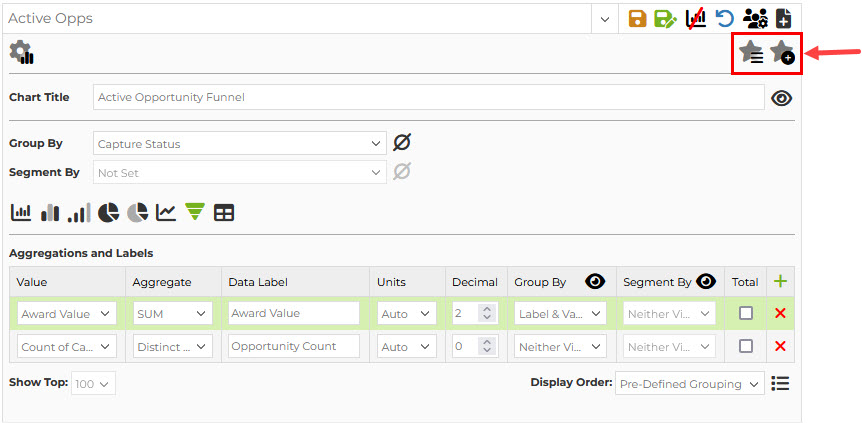
- Click the Start with the + sign to add a chart to your favorites. You will be prompted to name the chart for your favorites. This name does not need to match the chart title or the report name.
- Click the Start with the list (three horizontal lines) to access your favorites.
- Within this list, you can use the pencil icon to edit the name if you want it distinct from the name it was given in the report.
- Click the x to delete something from your favorites.

The favorite version of the chart will exist separately from the version saved in the report, so changes to the report will not affect it, and vice versa.
Calling up an existing favorite chart in a report will not save it to the report unless you save the changes to the report after opening the chart.